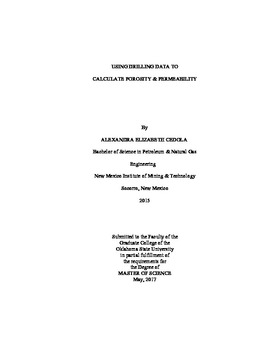| dc.contributor.advisor | Hareland, Geir | |
| dc.contributor.author | Cedola, Alexandra Elizabeth | |
| dc.date.accessioned | 2018-06-25T16:31:15Z | |
| dc.date.available | 2018-06-25T16:31:15Z | |
| dc.date.issued | 2017-05-01 | |
| dc.identifier.uri | https://hdl.handle.net/11244/300289 | |
| dc.description.abstract | Porosity and permeability are two important parameters for reservoir characterization, formation evaluation, and stimulation design. Typically, the methods for obtaining these two parameters are not only costly and time consuming, but can have a high degree of uncertainty. Drilling data can provide great insight into downhole occurrences, but it is commonly overlooked as a source of information. In this work, drilling data and an inverted rate of penetration (ROP) model are utilized to determine unconfined compressive strength (UCS) values at any point where drilling data has been collected. Using UCS and porosity values collected from laboratory measurements, a porosity representative correlation for sandstone and shale formations is established. Additionally, taking gamma ray measurements into consideration, a porosity correlation for mixed lithology zones is developed based on field data from three previously drilled wells in Alberta, Canada. Porosity and permeability data found through laboratory testing for various sandstone and shale formations has been collected and used to establish a correlation between the two parameters for the individual formations. Using the sandstone and shale porosity-UCS correlations, the collected laboratory porosity data is used to determine UCS for the individual sandstone and shale formations. The permeability is plotted with the corresponding UCS values for the various formations and a correlation between the two parameters is developed. Determining UCS from drilling data allows for both porosity and permeability data to be found and could potentially have real-time application potential.Knowledge of porosity and permeability in unconventional horizontal wells could be beneficial to stimulation design. Having the ability to find the porosity and permeability from drilling data would mean that these two parameters are known throughout a lateral and ultimately allow for optimization of selective stimulation. This could potentially reduce the need for logging, laboratory testing, and overall cost. | |
| dc.format | application/pdf | |
| dc.language | en_US | |
| dc.rights | Copyright is held by the author who has granted the Oklahoma State University Library the non-exclusive right to share this material in its institutional repository. Contact Digital Library Services at lib-dls@okstate.edu or 405-744-9161 for the permission policy on the use, reproduction or distribution of this material. | |
| dc.title | Using Drilling Data to Calculate Porosity & Permeability | |
| dc.contributor.committeeMember | Nygaard, Runar | |
| dc.contributor.committeeMember | Bikkina, Prem K. | |
| osu.filename | Cedola_okstate_0664M_15183.pdf | |
| osu.accesstype | Open Access | |
| dc.description.department | Chemical Engineering | |
| dc.type.genre | Thesis | |
| dc.type.material | text | |
